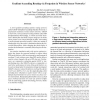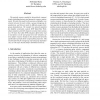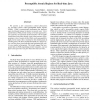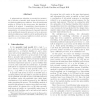99
Voted
RTSS
2005
IEEE
15 years 6 months ago
2005
IEEE
Static timing analysis safely bounds worst-case execution times to determine if tasks can meet their deadlines in hard real-time systems. However, conventional timing analysis req...
92
Voted
RTSS
2005
IEEE
15 years 6 months ago
2005
IEEE
Modern operating systems frequently support applications with a variety of timing constraints including hard real-time, soft real-time, and best-effort. To guarantee performance, ...
103
Voted
RTSS
2005
IEEE
15 years 6 months ago
2005
IEEE
A novel gradient-ascending stateless routing protocol, called GRASP (GRadient Ascending Stateless Protocol), is proposed for stationary wireless sensor networks. GRASP is built wi...
75
Voted
RTSS
2005
IEEE
15 years 6 months ago
2005
IEEE
The periodic resource model for hierarchical, compositional scheduling abstracts task groups by resource requirements. We study this model in the presence of dataflow constraints...
93
Voted
RTSS
2005
IEEE
15 years 6 months ago
2005
IEEE
nt a new concurrency control abstraction for real-time systems called preemptible atomic regions (PARs). PARs a transactional mechanism that improves upon lock-based mutual exclus...
63
Voted
RTSS
2005
IEEE
15 years 6 months ago
2005
IEEE
111
Voted
RTSS
2005
IEEE
15 years 6 months ago
2005
IEEE
In this paper we present a balanced data replication scheme that provides real-time latency bounds on content retrieval in content distribution networks. Many network applications...
113
click to vote
RTSS
2005
IEEE
15 years 6 months ago
2005
IEEE
We consider the scheduling of a sporadic real-time task system on an identical multiprocessor. Though Pfair algorithms are theoretically optimal for such task systems, in practice...
RTSS
2005
IEEE
15 years 6 months ago
2005
IEEE
This paper focuses on the hierarchical scheduling of systems where a number of separate applications reside on a single processor. It addresses the particular case where fixed pri...
109
Voted
RTSS
2005
IEEE
15 years 6 months ago
2005
IEEE
A polynomial-time algorithm is presented for partitioning a collection of sporadic tasks among the processors of an identical multiprocessor platform. Since the partitioning probl...




